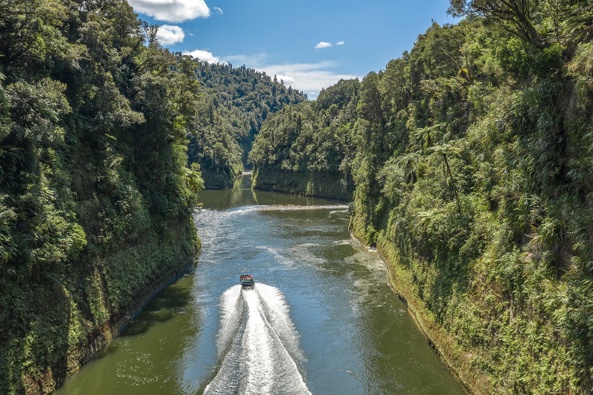It had long been on my wish list to grasp a flavour of one of our most evocative rivers, carving its way through the heart of the North Island. The mighty Whanganui, New Zealand's longest navigable river, stretching for 290km from its genesis as an alpine stream on the slopes of Mount Tongariro. My first foray with the awa began by following its lower reaches, from Whanganui to Pīpīriki on the winding trail of the Whanganui River Road. It’s an intimate, authentic and picturesque 64km-long riverside romp that feels charmingly removed, aloof – even defiant to the bustle of modern life, where small river communities steadfastly beat to their own pace, while honouring their natural and cultural heritage. With the visual panorama of the Whanganui National Park enrobing you, there’s no other riverside scenic driving route in New Zealand quite like it. It took 30 years to construct and finally opened in 1934.
An early frisson is driving over the crest of the hill from Upokongaro to be greeted by the Aramoana Viewpoint, serving up ravishing views of the grandeur of the river valley, the fiord-like march of the river, and Mt. Ruapehu, gleaming on the eastern horizon. You’ll pass by a multitude of Whanganui River marae starting at cute-as-a-button Pungarehu, where the whare tupuna was built in 1905 and houses one of the last historical waka used on the river. I shimmied by Oyster Cliffs, an aptly captivating name for the sheer cliffs that dramatically rise up from the road. They are layers of fossilised oyster shells, as the region was once seabed that’s been uplifted. Before long, I arrived at my riverside roost for the night, the Flying Fox Retreat. No accommodation experience that I’m aware of cuts such a striking first impression, quite like this place.
After entering the driveway to park the car on the eastern banks of the river, your means of access to the retreat is by suspended cable car, strung across the river. Sound the gong and the cable car soon whisks across to meet you. Being hoisted across the moody waters, with my luggage in toe, is quite the opening act! Exceptionally hosted by Jane and Kelly, they took over the retreat five years ago, after it was originally established as an accommodation venture by the former Whanganui Mayor, Annette Main. Quirky, eccentric and rustic, there’s also a touch of the storybook to this whimsical retreat, wrapped in such a splendidly primeval setting. Gnarly chimneyed cottages are perched high on the riverbank, nestled by a mini-forest of fruit trees, groaning with avocados, figs and apples. Perky hens free-range the orchard, while Jane’s magnificent home-baking wafts on the breeze. I half expected to spot some forest goblins on the curving paths through the bush to the river.
There are some venerable old buildings on-site, including the century-old Koroniti post office and the grand old homestead, where Jane and Kelly served up a hearty home-cooked dinner of wild venison. My fellow guests for the night were a vivacious group of women who were undertaking the Mountains to Sea Cycle Trail. The retreat is also popular with canoeists, whether it’s to drop in for the day or overnight. Jane and Kelly offer a variety of packages to incorporate those outdoorsy pursuits. There’s also a handy on-site shop selling food, treats, preserves, produce and the couple's artwork; Kelly paints, sculpts and carves while Jane felts and is a photographer. Do they ever rest in their oasis? The Flying Fox offers a variety of accommodation options, but it’s the three self-contained cottages that are prize draws, hand-built from reclaimed materials and comfortably furnished with carefully restored and upcycled items.
I stayed in the Riverboat Cottage, which was originally conceived by the previous owner as a place to brew manuka beer. The cottage has now been recast to honour the venerable river boats that previously plied these waters, as a lifeline to the river valley. The cottage walls are lined with fascinating pictures and artefacts paying homage to the past. With a second story bedroom, I slept
contentedly in my queen size bed, overlooking the river. The living area downstairs boasts a roaring wood burner, fully equipped kitchen and an eclectic mix of CDs, LPs and books to ramp up the sweet sense of escapism. www.theflyingfox.co.nz
The following morning, after savouring the celestial spectacle of that dawn mist brooding on the river, I farewelled The Flying Fox and headed further upstream, bound for Pīpīriki and a half-day tour with Whanganui River Adventures. I tootled through Rānana which is now the largest community along the road. Nearby, Moutoa Island, the scene of a short and fierce battle in 1864 between Whanganui Māori. The photogenic glory of Jerusalem, also known as Hiruhārama, reflected in the water as I approached the settlement, home to the century old St Joseph’s Catholic church and convent built in the 1890s. The church features a beautifully carved altar of Māori design and kōwhaiwhai panels adorn the walls. Marist Missioner, Mother Mary Joseph Aubert did wonders here. Her compassion, drive and respect for Māori elevated their health and childcare not only on the river, but later in Wellington.
Aubert was the founder of New Zealand’s only religious order, the Sisters of Compassion. She also set up a thriving business in Māori herbal medicine. Her secret formulas went with her to the grave. Jerusalem is also synonymous with James K Baxter’s commune, which closed soon after his death in 1972. Pulling into Pīpīriki, as the gateway to the upper Whanganui River, a hive of operators were gearing up for the day. I was joining the Bridge to Nowhere Tour with Whanganui River Adventures, which is operated by two local legends, Ken and Josephine Haworth. They live and breathe the river, having lived in the middle reaches of the river valley their entire lives. Rich historic tales have been passed down their respective generations, so their tour experience is loaded with indelible family insights. Ken has been driving commercial jet boats for over 35 years, so I felt in the safest of hands on these mystical waters.
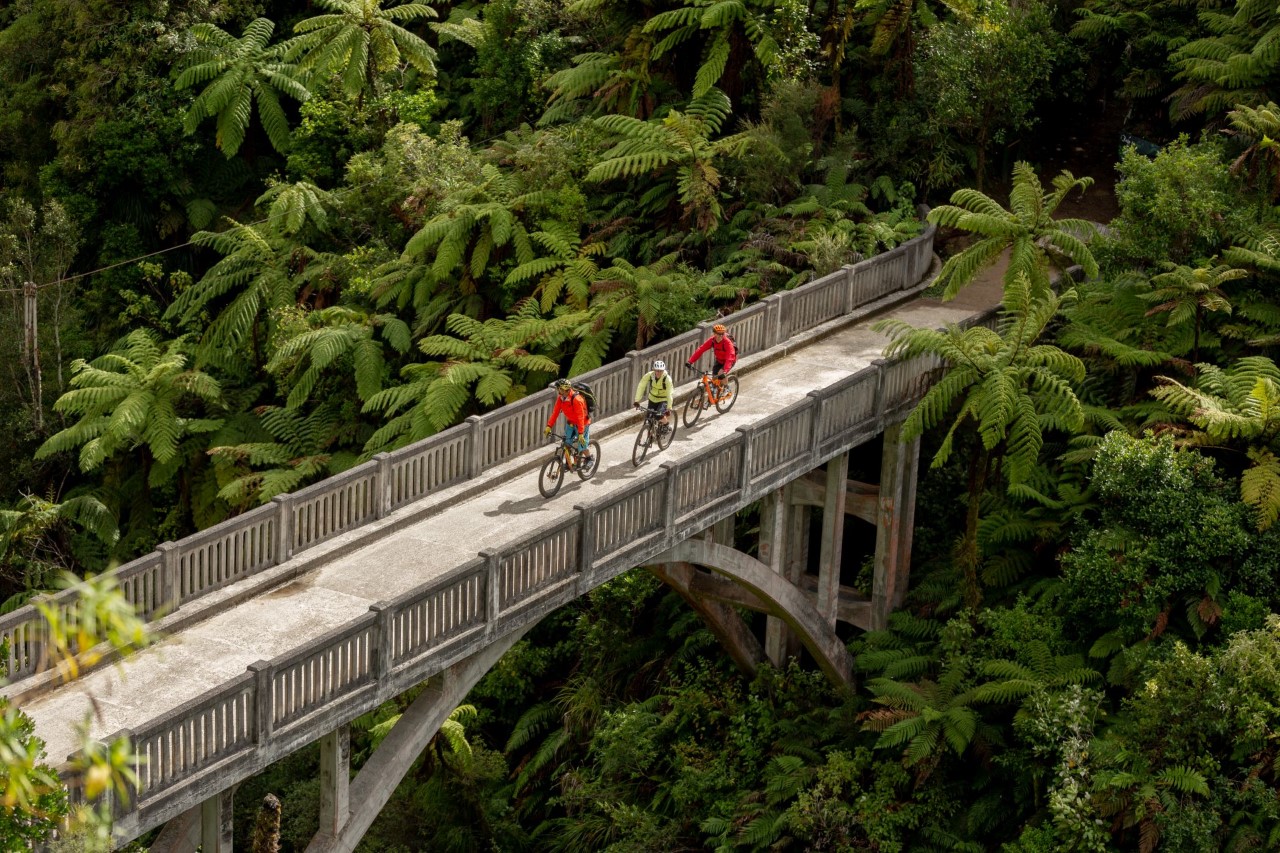
Operating the only local Māori-owned commercial jet boat touring business on the river, it is not just their seasoned experience, local knowledge and worldly reverence for the region that gushes forth, but also their deep aroha and respect for the river. My half-day tour not only felt highly personalised but authentic. You could not wish for a richer experience. As we made our way through the wilderness reaches of the river, en-route to the Bridge to Nowhere, Ken regaled our group with enthralling anecdotes, highlighting the characters who made their mark on the river, its shifting fortunes, the natural splendour and the venerated Māori history. This is papa country. The land surrounding the river is only about one million years old, formed from soft sandstone and mudstone (papa) from the ocean-bed.
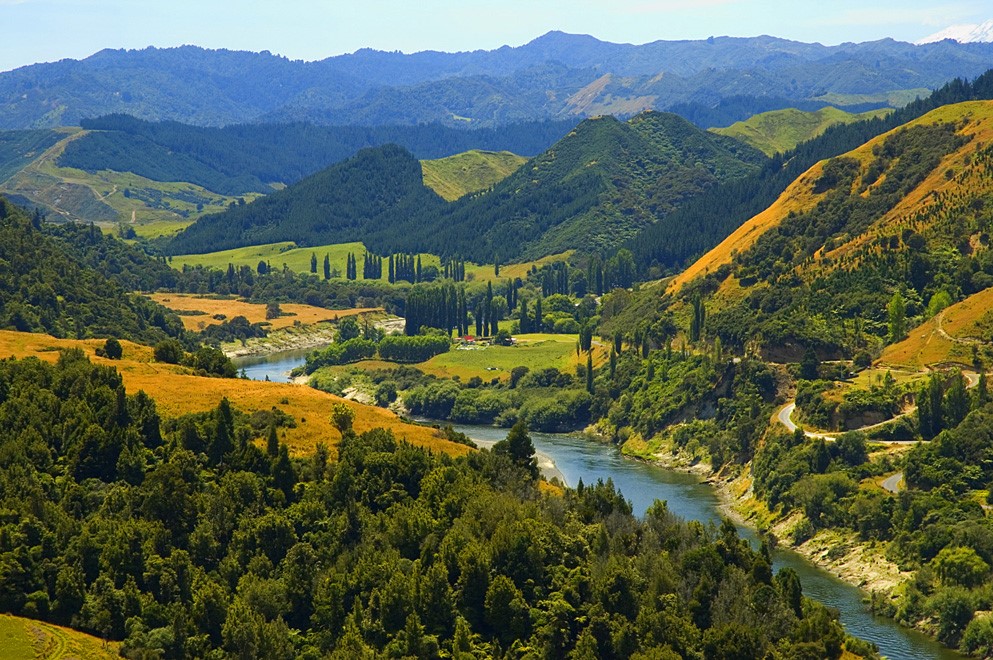
Eroded by water to form sharp ridges, deep gorges, sheer papa cliffs and waterfalls, mop-topped with a broadleaf podocarp forest, the verdant visual symphony is a constant as we purred upstream. Tree ferns and plant life cling incredulously to the cliff faces, growing at improbable angles. I learnt how Māori cultivated the sheltered terraces and built elaborate eel weirs along river channels where eels and lamprey were known to converge. Ken pointed out the round holes of toko (canoe poles), stamped in the papa cliffs, to help them navigate the wild rapids, over the course of hundreds of years. Every bend of the river had kaitiaki (guardian) which controlled the mauri (life force) of that place. We skirted into some tributaries that felt so lost-in-time, I half expected a fleet of fully-crewed waka to emerge on the water to greet us.
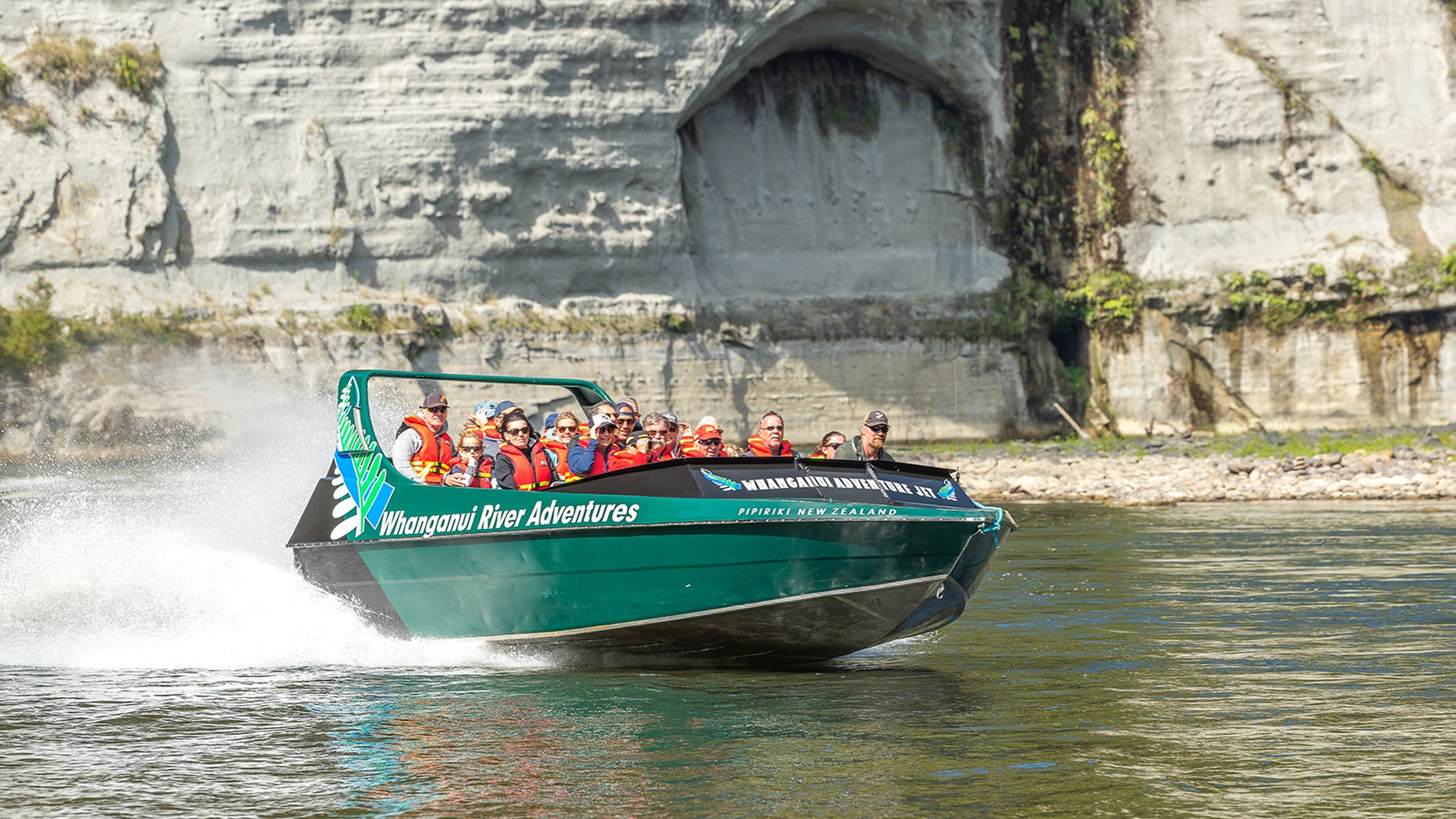
There is an unmistakeable sense of something special about the place, a depth of mood, a certain energy that accentuates the drama of the encounter, particular in the deeply incised gorge. The first significant European influence arrived with missionaries in the 1840s. By the 1890s, a regular riverboat service began carrying passengers, mail and freight to settlers on the river between
Taumarunui and Pīpīriki and a booming tourist trade soon began between Mt. Ruapehu and Whanganui. Ken introduced us to one of the towering figures of this time, Alexander Hatrick. His first steamer, the Wairere, made her first trip to Pipiriki in 1891, evolving into his 12-strong fleet of riverboats connecting Whanganui with Taumarunui, including the PS Waimarie that Thomas Cook & Son contracted Hatrick to carry tourists on. (That vessel was gloriously restored in 2000 and operates cruises from Whanganui on the river’s lower reaches.)
Billed as “The Rhine of New Zealand,” the river was a burgeoning artery, the major highway, moving goods and people between Whanganui and Taumarunui. A combination of the road and the main trunk railway opening up cratered demand for the riverboats, which finally stopped operating in the 1950s. But their legacy is unforgettable. Ken remarked that you will still see haybales and even sheep shifted down the river by jetboat. After taking our fill of the river’s majesty, we tied up at Mangaparua Landing, for our gentle 40 minute walk through the magnificent podocarp forest to reach the Bridge to Nowhere, intimately shadowed by fearless North Island robins, eager to grab the grubs unearthed by our footprints. Splashed in sunshine and thickly bracketed in pungas, it’s a pinch-yourself setting. The Mangapurua and Kaiwhakauka valleys were rehabilitation settlements where land was offered to returning soldiers from WWI. The back-breaking endeavours of these pioneering settlers, clearing much of the virgin forest for farmland, is exhausting just to contemplate.
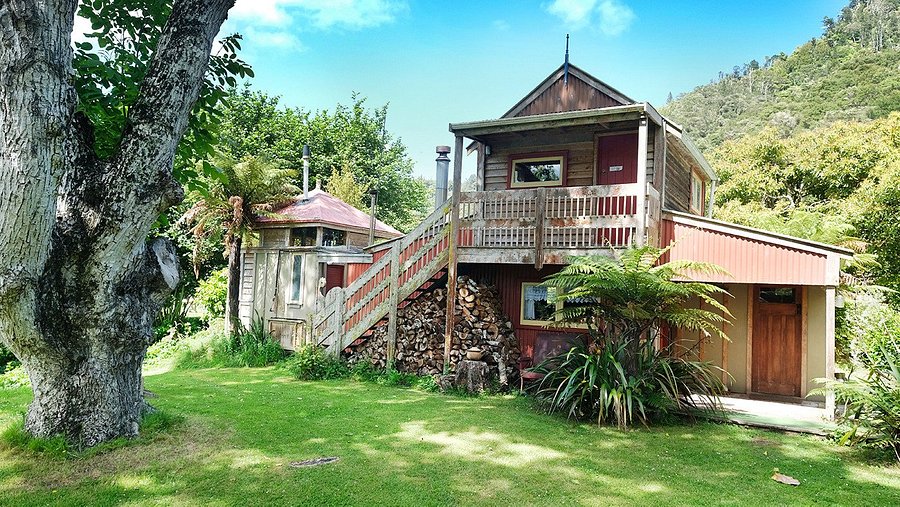
At its peak, there were 30 farms in the Mangapurua. Today, only a few chimneys, exotic trees and hedges mark the remains of the house sites. Poor access, erosion and collapsing wool prices all conspired to force most of the settlers to abandon their farms. The hold-outs finally left in 1942 when the government refused to maintain the storm-battered road. The historic arched Bridge to Nowhere, a great slab of stylised and suspended concrete straddling the Mangaparua Stream, was finally completed in 1936 after many years of toil, in a bid to improve road access. But it was all too late. By the time the bridge was finished, the lower valley had already been deserted by the settlers. It’s been a tour de force to reclaim the bridge from the clutches of the bush, which Ken vividly illustrated with some family photos. It’s an iconic structure deep in the wilderness, a totem to epic if not misguided toil, and utterly enthralling to experience. www.whanganuiriveradventures.co.nz
I tripped around the North Island in an Avis rental car. Alongside great deals, enjoy Digital Check-in to minimise physical contact with rental staff and Risk Free Bookings allowing you to change or cancel reservations, without fees, for rentals due to start before 19 December 2021. www.avis.co.nz
The drama, diversity and grandeur of the Ruapehu District sets the stage for spectacular year-round outdoorsy adventure, with experiences that cater for all age ranges and abilities. Blessed by two national parks – Whanganui National Park to the west and the world-heritage wonder of Tongariro National Park on its eastern flank, make your first stop the region’s official website. www.visitruapehu.com
Mike Yardley is our resident traveller on Jack Tame Saturday Mornings.
LISTEN ABOVE
Take your Radio, Podcasts and Music with you

